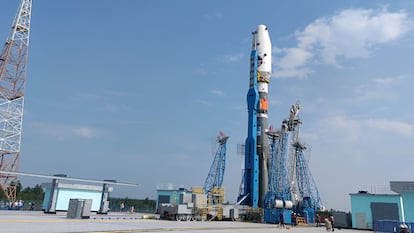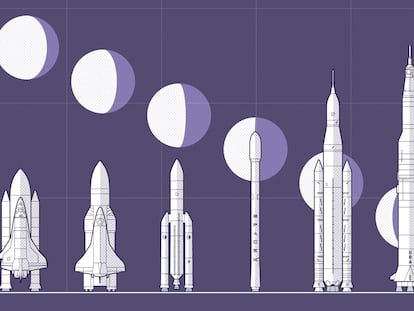Russia launches mission to be the first country to extract water from the Moon
The ‘Luna-25′ probe is trying to make history by successfully landing on the hostile south pole, the new promised land of space exploration

In the midst of a war with Ukraine, as it faces off against the West, Russia is going to try to make history by becoming the first country to successfully land on the south pole of the Moon, the new promised land of space exploration.
On Friday, Moscow plans to launch Luna-25, a robotic probe which intends to land near the Boguslawsky crater, a depression 60.3 miles (97 kilometers) in diameter. Landing a spacecraft on the south pole of the Moon presents many challenges, as the area is riddled with craters. But it also may be home to extremely valuable ice reserves that are probably hidden underground in areas which, due to the position of the Moon, are in constant darkness.
The name of the mission is no coincidence. Russia is alluding to the Soviet probes of the 1960s and 1970s that were the first to orbit the Moon, land on its surface and show its hidden face — feats Russia achieved before the United States. Luna-24 managed to reach an equatorial zone of the Moon, take soil samples and send them back to Earth in 1976. It was quite a feat, but the problem was that by then the United States, determined to win the space race, had already managed to send astronauts to the Moon, who returned with lunar rocks.
Half a century later, the world is witnessing a new race to the Moon led by the United States, which wants to send astronauts to the south pole of the Moon within two years. Russia is unable to match that feat, but with Luna-25, it can become the first nation to land in that unexplored area and touch, for the first time, lunar water.
80% chance of success
“We still have the experience of the Soviet era, and we have prepared very carefully for this landing,” Lev Zeleny, scientific director of the Russian Space Research Institute, told RT. “I think we have taken into account the main difficulties, and I hope that the landing will be soft.” Mission engineers estimate that the mission has at least an 80% chance of success.
The Luna-25 is scheduled to take off on Friday aboard a Soyuz-2.1b rocket from the Vostochny Cosmodrome in northeastern Russia. The location was chosen in part so that the entire mission stays within Russia’s borders (normally, rockets are launched from Kazakhstan). It also allows for a more direct trajectory that avoids large inhabited areas. As a precaution, Russia has evacuated 26 residents of the village of Shakhtinsky, who will be accommodated in a hotel and invited to watch the takeoff, Reuters reports.

The mission is years behind schedule due to ongoing technical difficulties, including the failure of its predecessor Phobos Grunt, a joint Chinese-European project aimed at reaching Mars. The war in Ukraine and Western sanctions have been another huge stumbling block. Before the invasion of Ukraine, the European Space Agency was going to contribute to the project with a camera, but that plan was canceled and Russia has no choice but to go to the Moon alone.
The primary landing spot has been carefully selected using data taken by the U.S. orbital probe LRO. Two secondary locations have been identified in case something goes wrong. The Russians believe that the Boguslawsky crater (named after a Prussian artillery officer who took part in the invasion of Russia during the Napoleonic wars) is one of the points on the pole where there may be more water, a key element for future manned missions. Oxygen and hydrogen can serve as rocket fuels to one day travel to Mars and beyond, while water can support the first human colonies.
Landing on the Moon is always a huge challenge — only the United States, Soviet Russia and China have managed it — because there is no atmosphere to slow down a spacecraft. The Luna-25 will have to rely on its rockets to reduce its speed and avoid landing on a steep area and falling over, which happened to some of its predecessors half a century ago. Last April, the Japanese probe Hakuto-R crashed trying to land on the Moon.
Heat with plutonium
On the Moon, there are 14.5 Earth days of sunlight and as many at night. During the day it reaches 250ºF (120ºC), but when the sun goes down, the temperature at the pole can drop to more than 200ºC below zero. The Russian probe is carrying solar panels to operate during the day and a radioisotope device to generate heat with plutonium at night, when it hibernates until dawn.
The Russian spacecraft is carrying eight scientific instruments. The most striking is a robotic arm that will dig a few centimeters in search of ice, collect a sample and analyze it with different instruments capable of detecting whether there is water, how much of it there is and possibly its origin. The probe is also equipped to search for other elements of interest: thorium, potassium, and uranium.

It is thought that 4.5 billion years ago, Earth collided with Theia, a planet the size of Mars. The impact was so big that a small part of Theia was ejected and mixed with the remains of a young molten Earth. The result was the Moon.
Whether the Moon’s water is a holdover from that time or whether it came aboard asteroids and comets that impacted both the Moon and Earth is a huge mystery. “The first excavation of the lunar polar regolith will be a step into the unknown,” the mission’s scientific leaders said in a recent analysis. “The study of macromolecular compounds of cosmic origin preserved in lunar glaciers can reveal the secret of the origin of life on Earth and will allow us to compare biochemical molecular structures on Earth and in space,” they explained.
Luna-25 is the first in a series of missions with which Russia wants to return to the Moon after more than 40 years. “The Russian lunar program is already planning the next landing craft based on the development of the Luna-25 design,” said Maxim Litvak, one of the mission’s chief scientists. “After Luna-26, which will be an orbital probe, two landing stations will follow. Luna-27 will carry a drilling rig [to penetrate five feet into the ground], and Luna-28 will bring soil from the Moon’s polar region to Earth.”
After takeoff, scheduled for early Friday morning, the Russian spacecraft will take between four and five days to reach the Moon. Once there, it will orbit for a few more days until it ignites its rockets and begins its descent towards the south pole. If all goes to plan, it won’t win the space race, but it will make history.
Sign up for our weekly newsletter to get more English-language news coverage from EL PAÍS USA Edition
Tu suscripción se está usando en otro dispositivo
¿Quieres añadir otro usuario a tu suscripción?
Si continúas leyendo en este dispositivo, no se podrá leer en el otro.
FlechaTu suscripción se está usando en otro dispositivo y solo puedes acceder a EL PAÍS desde un dispositivo a la vez.
Si quieres compartir tu cuenta, cambia tu suscripción a la modalidad Premium, así podrás añadir otro usuario. Cada uno accederá con su propia cuenta de email, lo que os permitirá personalizar vuestra experiencia en EL PAÍS.
¿Tienes una suscripción de empresa? Accede aquí para contratar más cuentas.
En el caso de no saber quién está usando tu cuenta, te recomendamos cambiar tu contraseña aquí.
Si decides continuar compartiendo tu cuenta, este mensaje se mostrará en tu dispositivo y en el de la otra persona que está usando tu cuenta de forma indefinida, afectando a tu experiencia de lectura. Puedes consultar aquí los términos y condiciones de la suscripción digital.
More information
Últimas noticias
The new victims of the Republican war on Obamacare: Millions hit by soaring health insurance premiums
A country divided on migrant rights: Some US states expand protections while others restrict them
Venezuela authorizes the release of another 87 political prisoners
There is as much life left to discover on planet Earth as that which is already known
Most viewed
- David King, chemist: ‘There are scientists studying how to cool the planet; nobody should stop these experiments from happening’
- Reinhard Genzel, Nobel laureate in physics: ‘One-minute videos will never give you the truth’
- Oona Chaplin: ‘I told James Cameron that I was living in a treehouse and starting a permaculture project with a friend’
- Sinaloa Cartel war is taking its toll on Los Chapitos
- The Interoceanic Train, the Mexican alternative to the Panama Canal











































